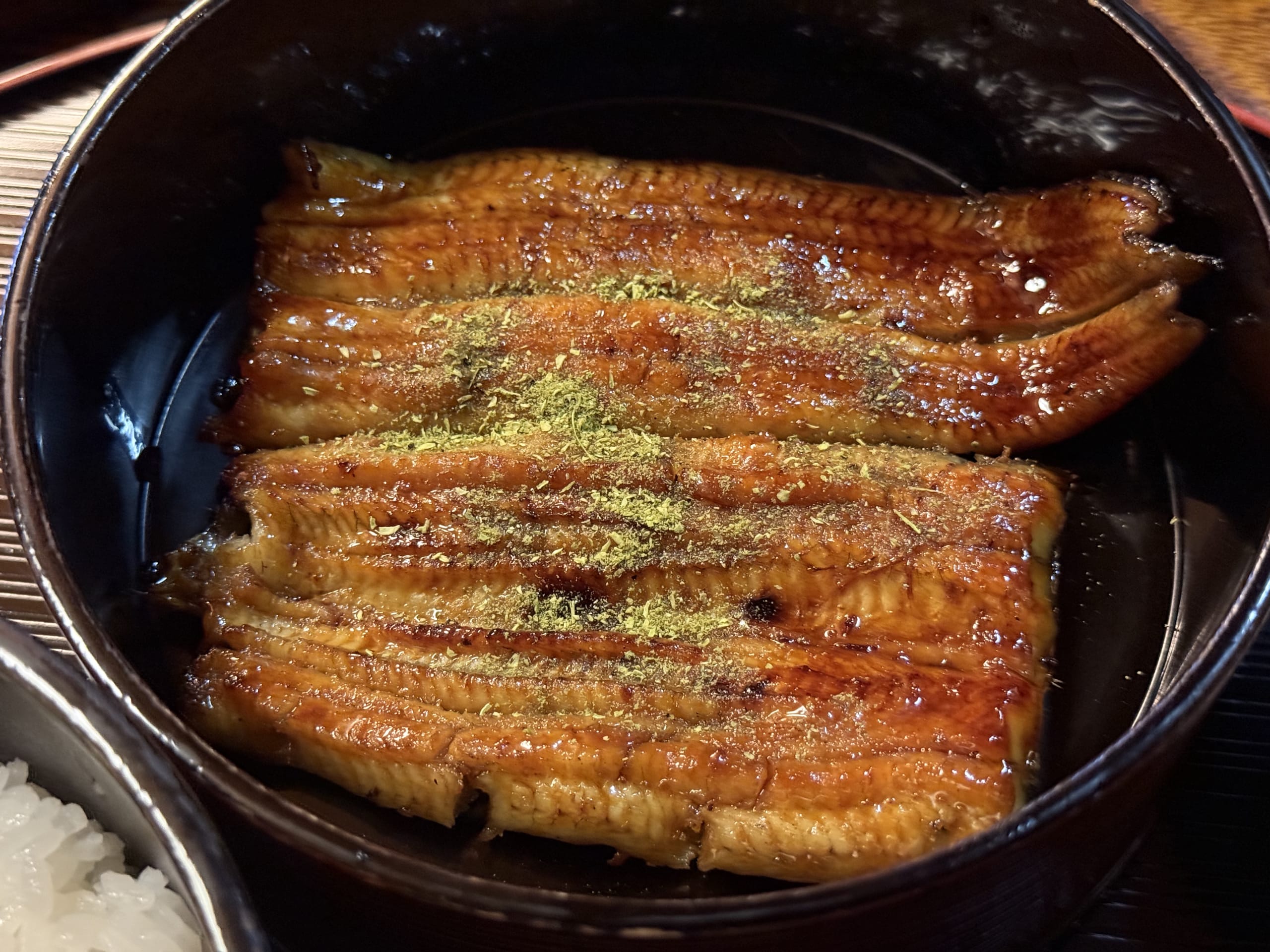Seeking Sumptuous Unagi in Sizzling Tokyo: A Journey to Akimoto in Kōjimachi
Hello, this is CityNomix from Photomo. While my days are usually immersed in the hustle of digital marketing, I also wander the streets of cities, both at home and abroad, unearthing local culture and sharing it through words and photos. This time, I’m excited to take you on a sensory journey to Unagi Akimoto Kōjimachi, a renowned establishment boasting the prestigious title of a Tokyo unagi old & Michelin-starred restaurant, nestled in the heart of Tokyo’s Kōjimachi district.
It was June, yet the Tokyo sky already blazed with a midsummer-like intensity. After a two-hour meeting with a client, I stepped out of the office building into a wave of humid heat. “This… calls for some serious energy boosting,” I thought. And what came to mind as the ultimate revitalizer? Yes, unagi (eel).
Fortunately, Kōjimachi, my client’s Hanzomon-adjacent neighborhood, is home to a name revered by gourmands: “Unagi Akimoto.” With over 110 years of history and a coveted spot in the Michelin guide, this purveyor of old taste unagi consistently ranks high on my lunch list. “Alright, Akimoto it is.” With unwavering resolve, I began the roughly 10-minute walk from my client’s office.
An Exterior Steeped in History, An Interior of Serene Japanese Ambiance
Dodging the strong sun, I navigated the side streets until a building radiating an air of distinction came into view: “Unagi Akimoto.” Its facade exuded a venerable charm that can only be cultivated over many years.
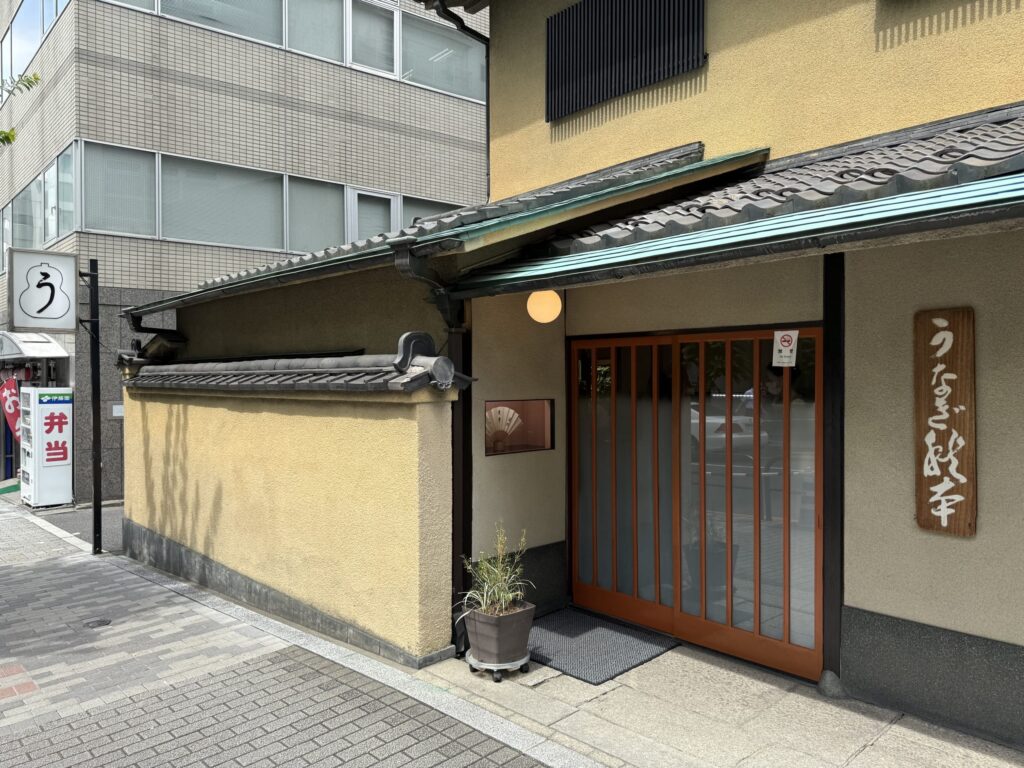
It was just past 1 PM on a Monday. I had hoped the lunch rush would have subsided, but the restaurant was bustling. “Ah, still crowded, I see.” The ground floor was full. Thankfully, I was guided to a tatami room on the second floor.
Ascending the stairs, I was shown into a charming Japanese-style room. The scent of tatami mats and the soft light filtering through shoji screens created an oasis of calm, a world away from the city’s clamor. A kakejiku (hanging scroll) adorned the tokonoma (alcove), lending an air of quiet dignity. While the first floor’s counter seats overlooking a small garden are appealing, this second-floor tatami room offered a wonderful, tranquil space to savor the meal.
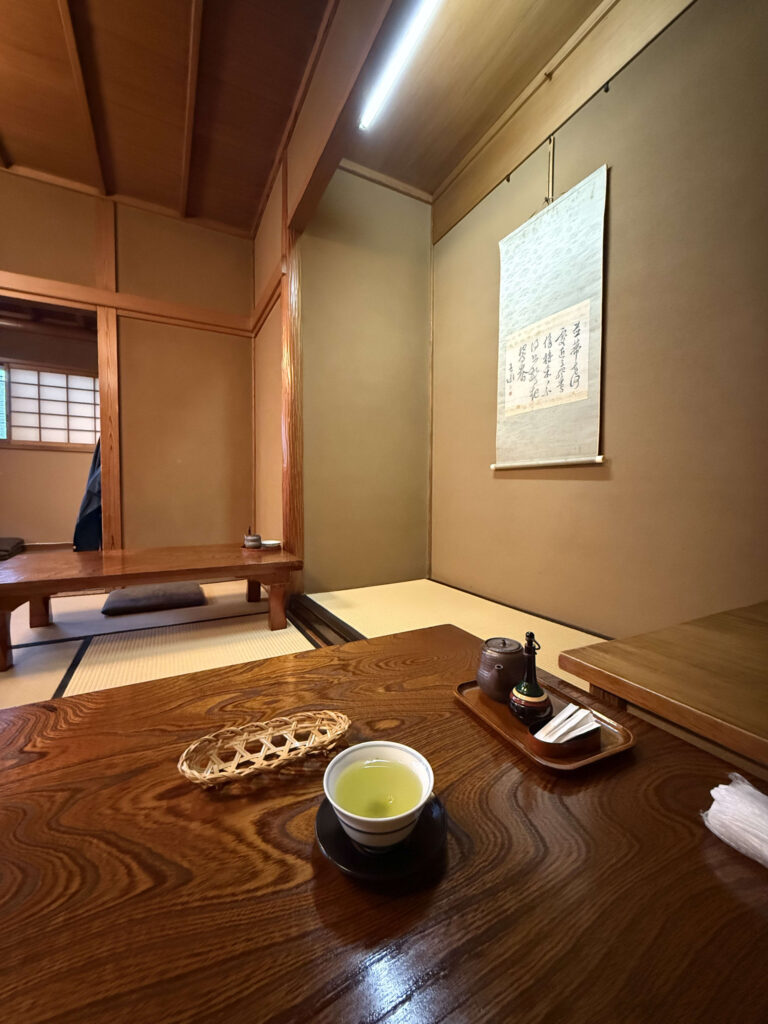
“Please use the zabuton (cushion) for your back,” a staff member said kindly, offering warm tea. This quintessential Japanese omotenashi (hospitality) eased my tension and set a welcoming tone, further heightening my anticipation for the culinary experience to come.
A Menu Etched with History, An Unwavering Choice
Now, to peruse the menu. The vertically written list of dishes was tempting, but my heart was set: “Unajū” (broiled eel on rice). And the “Ume” (plum) grade, offering a generous portion of eel, felt just right for my mood today.
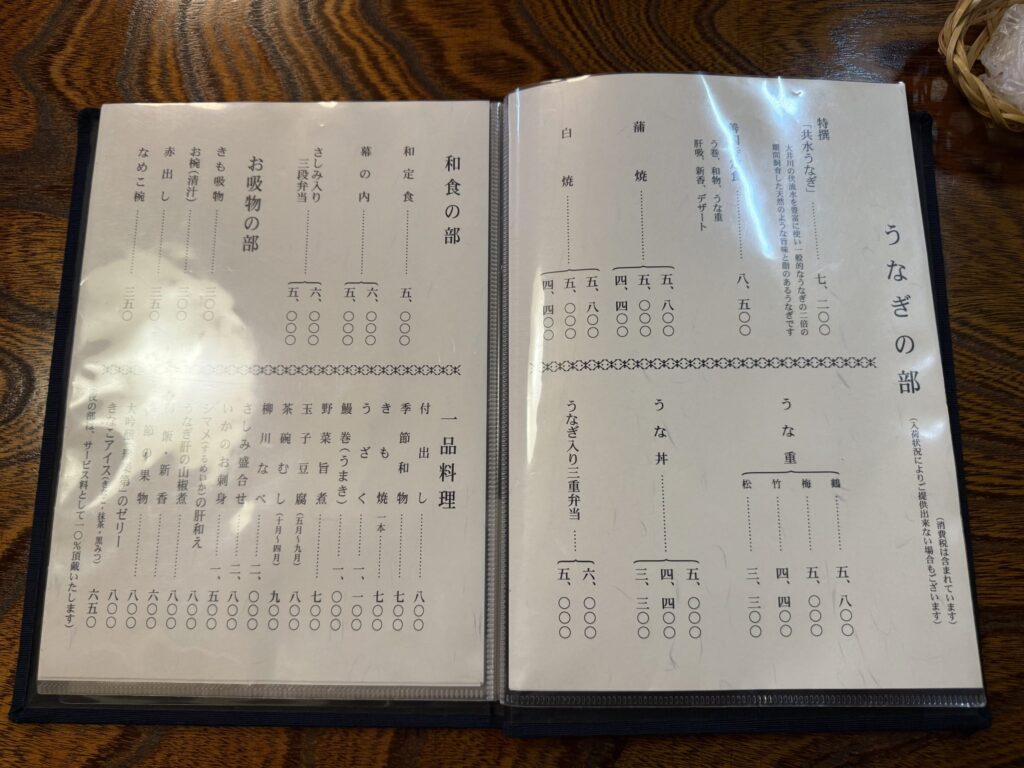
At “Akimoto,” the amount of eel in the unajū varies with the price. Notably, from the “Ume” grade upwards, the eel and rice are served separately in a two-tiered jūbako (lacquer box). This presentation style is another delightful touch. Furthermore, their aka-dashi (red miso soup) is known for its profound flavor, a perfect complement to unagi, so I added it without hesitation. “Unajū Ume and aka-dashi, please.” Order placed, I settled in to wait.
An International Flavor and Anticipatory Moments
Glancing at a nearby table, I noticed some international visitors accompanied by a Japanese host. We exchanged a brief, polite nod. Experiencing traditional Japanese unagi at such a historic establishment must be a special occasion for visitors from overseas. As a digital marketer and a fellow traveler, witnessing these moments of cultural exchange is always fascinating.
“Akimoto” prepares the eel fresh after an order is placed, so there’s a bit of a wait. However, this anticipation only enhances the experience. The chefs must be remarkably efficient, as the wait didn’t feel overly long. It was, rather, a pleasant interlude filled with eager expectation for the sublime flavors to come.
The Grand Reveal: A Two-Tiered Box Promising Bliss
And then, the moment arrived. “Omatase itashimashita (Thank you for waiting).” Before me was placed a jet-black, two-tiered jūbako: the Unajū “Ume.” The mere sight of it instilled a sense of deep satisfaction.
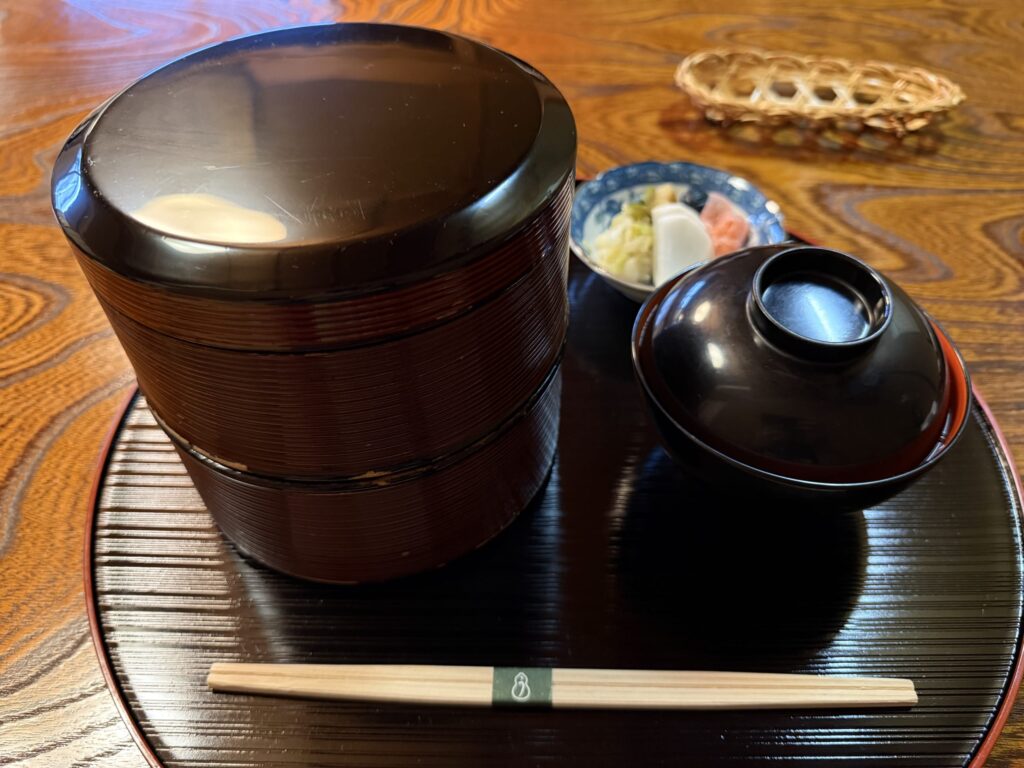
Gently lifting the lid of the top tier revealed the glistening, jewel-like kabayaki (grilled eel). The tantalizing aroma of the savory tare (sauce) tickled my nostrils, fiercely stimulating my appetite. Opening the bottom tier unveiled fluffy, perfectly cooked white rice. A flawless presentation.
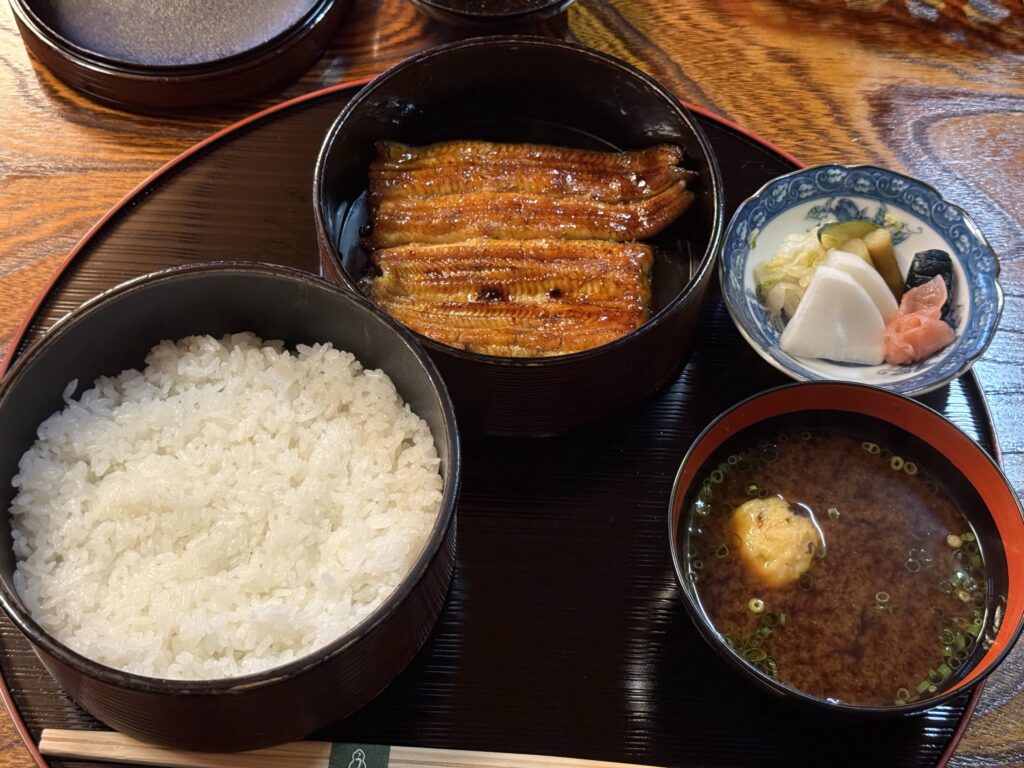
Opening the aka-dashi bowl released a rich, fragrant miso aroma. Time to eat… no, wait. There was one crucial ritual remaining.
Homemade Sanshō: The Ultimate Harmony with Unagi
Indeed, one of the cornerstones of “Akimoto’s” excellence: their homemade sanshō pepper. From a small pot on the table, I generously sprinkled the vibrant green pepper onto the eel. This sanshō is the final, essential element that completes Akimoto’s unagi.
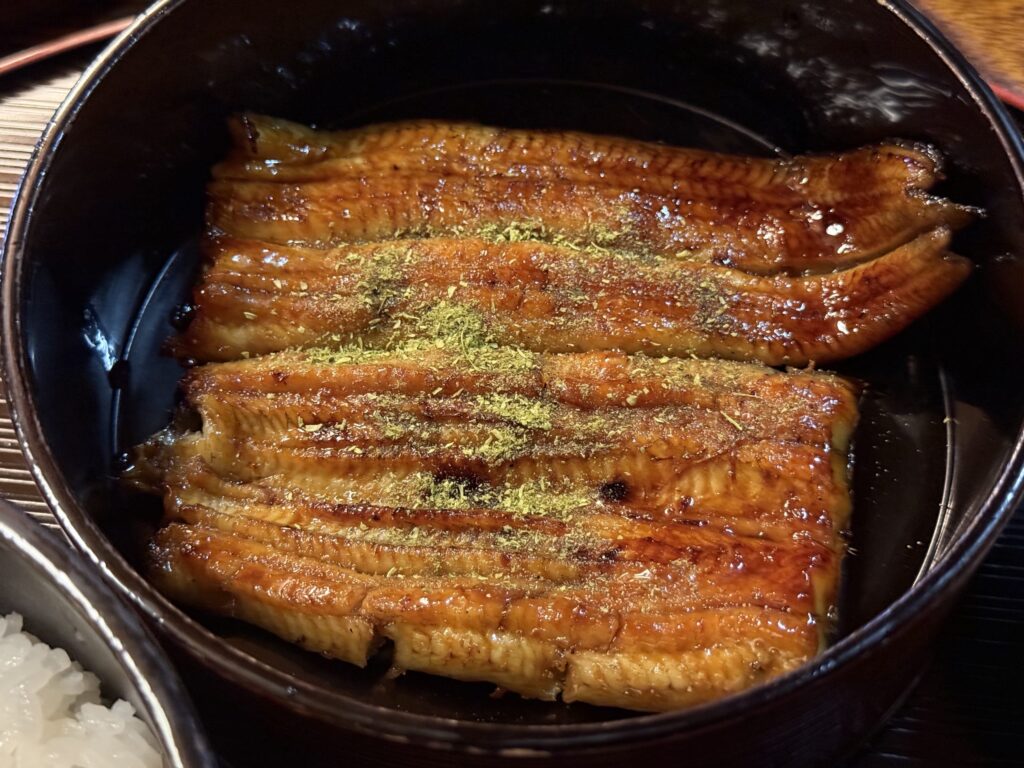
The freshly ground sanshō offers a fragrance far superior to any store-bought variety. Its tingling spiciness and refreshing citrus notes elevate the rich umami of the eel and the sweet-savory tare, creating a complex and profound flavor profile. The summer heat-induced lethargy seemed to dissipate instantly with the invigorating aroma of this sanshō. This is a key element of a truly Tokyo delicious unagi restaurant.
A Bite of Bliss, And a Cascade of Combinations
At last, I picked up my chopsticks. The incredible tenderness of the eel was apparent even before tasting; “horo-horo” (fall-apart tender) is the perfect descriptor. The sweetness and depth of the tare, combined with the eel’s natural richness, melted in my mouth, a wave of pure bliss. The homemade sanshō then cut through with its clean, sharp finish.
This trinity of tare, eel, and sanshō is nothing short of artistic. Each bite fueled an insatiable appetite. A mouthful of rice, lightly kissed by the tare, further amplified the eel’s umami. This is the hallmark of an exceptional Tokyo unagi experience.
The accompanying aka-dashi was equally superb. It embraced the rich eel flavor while its deep umami refreshed the palate. The tsumire (fish balls) within offered a light, clean taste, a welcome counterpoint. And one must not forget the tsukemono (pickles). Each piece was a testament to careful preparation, worthy of a specialty pickle shop. Their restrained saltiness and elegant flavor provided an excellent interlude between bites of eel.
Unagi, rice, sanshō, aka-dashi, pickles… this symphony of flavors never allowed for a dull moment. It was a meticulously orchestrated “combination of deliciousness,” a signature of the old taste unagi tradition refined by a Michelin unagi lunch contender.
A Lingering Farewell and Heartwarming Hospitality
The dreamlike meal passed all too quickly, and soon the jūbako was empty. The fragrant hōjicha (roasted green tea) served midway through gently mellowed the rich unagi flavors, providing a comforting end to the feast. “Ah, that was truly delicious today.” A deep sense of satisfaction permeated my being. This would surely fuel me through Tokyo’s demanding summer.
After a brief pause, I went to the register to pay. The familiar staff member seemed to recognize me. “Itsumo arigato gozaimasu. Mata okoshi kudasaimase (Thank you for your continued patronage. Please come again).” These warm words resonated deeply. It’s this genuine hospitality that makes me want to return, again and again. This is the spirit of service, passed down alongside the old taste unagi.
Unagi Akimoto, Kōjimachi – Where Tradition and Innovation Thrive in Tokyo’s Premier Eel Restaurant
Unagi Akimoto in Kōjimachi is more than just a place for delicious eel; it’s an institution where over 110 years of traditional craftsmanship and a spirit of continuous evolution coexist. Its Michelin star is a testament to its unwavering quality, solidifying its status as a provider of Tokyo premium unagi.
If you are seeking a truly delicious meal in Tokyo, or a memorable experience for a special lunch or dinner, Unagi Akimoto will undoubtedly exceed your expectations. At this distinguished establishment, a beacon of Tokyo premium unagi that welcomes you with warm hospitality, I urge you to savor their supreme unajū. It is an especially fine choice for a Michelin unagi lunch.
Invigorated by the unagi, I headed to my afternoon client meeting, the lingering, refreshing scent of sanshō pepper seeming to cheer me on.
Restaurant Information
Unagi Akimoto
Official Website: https://www.unagi-akimoto.com/
Google Map :
Photomo CityNomix’s Perspective:
Date & Time of Visit: Monday, June 23, 2025, around 1:00 PM
Weather: Cloudy (but humid and hot)
Crowd: Past peak lunch hour, but the first floor was full. The second floor was about half occupied. Reservations might be advisable.
Price Range: Unajū Ume (approx. ¥5,000~, subject to market price fluctuations), Aka-dashi (several hundred yen). While it’s a premium restaurant, the quality justifies the cost.
Highlights:
- Incredibly tender and fluffy eel, prepared and grilled to order.
- The exquisite harmony of the secret tare sauce and fragrant homemade sanshō pepper.
- The serving style of Unajū “Ume” and above, with eel and rice in separate tiers.
- The serene traditional Japanese ambiance and attentive service.
- The historic building and prime Kōjimachi location.
Points to Note:
- As it’s a popular restaurant, it’s wise to allow ample time, especially during lunch, or consider making a reservation.
- Eel prices may vary depending on the market.
On your next visit to Tokyo, or when looking to treat someone special, I highly recommend a visit to Unagi Akimoto. An unforgettable culinary experience awaits.

